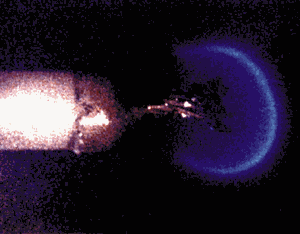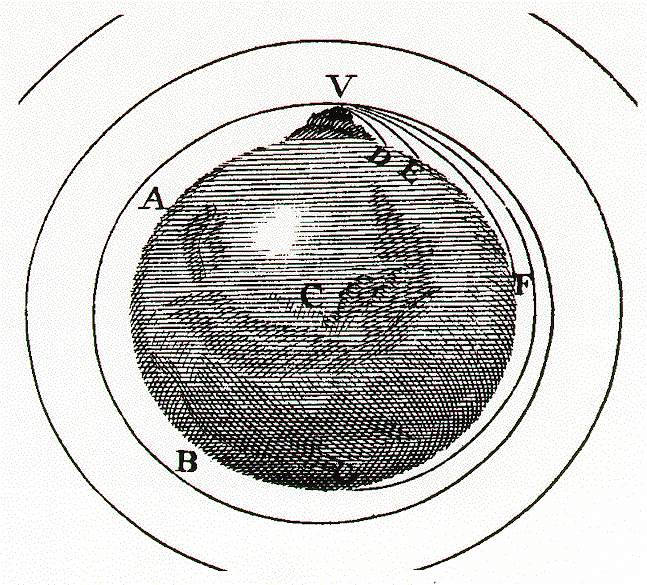
A teacher Institute workshop on 11 October, 2008
Weightless flight of discovery
Freefall
Drop a slinky, in freefall it expands to model the behavior of an astronaut spine.
Drop a candle and observe that in freefall there is no convection.
A candle in freefall: 
Nasa video of a candle in space http://www.nasa.gov/mov/196821main_056_Combustion_Experiments.mov
Flameballs in space, Hydrogen and oxygen in an inert gas (sulfur hexafluoride) burn as spheres in free fall.
http://carambola.usc.edu/research/SOFBALL2quickie.html
movie here http://carambola.usc.edu/research/SOFBALL2quickie_files/2LargeBalls_TP08A.mov
Astronaut in freefall on skylab
Falling
Falling, If you shoot a bullet horizontally out over a lake, and drop a bullet at the same instant, both bullets will hit the water at the same time.
Fire a bullet in the absence of an atmosphere at just the right speed and it can fall at the same rate that the surface of the spherical earth falls away. This bullet is then in orbit. A Swift rifle can fire a bullet with a high enough velocity, 1200 m/s, to orbit the moon and hit the shooter in the back of the head.
How to Fly. In the "Hitchikers Guide to the Galaxy" Arthur Dent discovers the secret of flying. When you trip and start to fall toward the ground, get distracted so that you miss the ground. This is a good description of an orbit, you fall but you miss the ground.
If you back up and look at the earth from a distance you will notice that as you fall the earth begins to curve away as well. Newton proposed shooting a cannon with a ball that accelerated toward the center of the earth due to gravity at just the same rate that the surface of the earth fell away. If you do this you find that the ball will fall around the earth forever in a circle, an orbit.

You may ride the cannon ball in a simulation of this exhibit in the Exploratorium sim in Second Life.
http://slurl.com/secondlife/Exploratorium/123/129/901/?title=Newton%27s%20Cannon
Another newton orbit simulation http://Galileo.phys.Virginia.EDU/classes/109N/more_stuff/Applets/newt/newtmtn.html
and another http://www.waowen.screaming.net/revision/force&motion/ncananim.htm
Gravitational Acceleration and Falling
In a closed room you annot tell the difference between whether the room is sitting still in a gravitational field which produces a downward acceleration or whether the room is accelerating upward. This is the equivalence principle of general relativity. So if we combine these two a gravity force down creating an acceleration of g down, and an acceleration down also at g which would be equivalent to a gravity field from above. The two acceelerations would produce canceling effects in the room, a state known as freefall.
Weightless Dog http://www.leechvideo.com/video/view1937558.html
Weight
The usual definition of weight is the gravitational force on an object. Thus an object in orbit or freefall is not weighless because the gravitational force is only slightly less than the force on the object at the surface of the earth.
However an operational definition of weight is that weight is what is measured by a scale. Using this definition an object in freefall is weightless.
Orbits
Copernicus wrote the book titled "On the Revolution of the Heavenly Bodies" which contained such idea changing concepts that its title word came to be the name for any great change, a revolution. The revolutionary idea was that the Earth Orbited the sun.
Language note: Planets revolve about the sun in their orbits and rotate about their axes.
By this naming the six-shooter handgun of the American west should be a rotator not a revolver. The gun part containing the bullets rotates, the bullets themselves revolve.
Kepler used Tycho Brahe's observations of the motions of the planets to come up with three laws of planetary motion.
1. Orbits of planets in our solar system are ellipses with the sun at one focus.
2. Planets sweep out equal areas in equal times.
3. The period of a planets orbit squared is proportional to the radius of the orbit cubed.
Newton then showed that all of Kepler's observations were produced by a force of gravity that obeyed an inverse square law.
Planetary orbit simulator http://astro.unl.edu/naap/pos/animations/kepler.swf
This simulator shows Kepler's laws nicely.
Gravity Well:
Many science museums have a "Gravity Well" exhibit. A toy coin bank version of the gravity well is also available. Balls rolled in the well model the behavior of planets orbiting the sun in nearly circular orbits. Planets far from the sun travel at low velocity over a large circumference and take a long time to orbit. Planets close to the sun travel a short distance at a high speed during each orbit.
Here is how to explore a gravity well. Gravity Well
You can also explore orbits in different force fields, rolling balls in spherical bottomed bowls or balloons, or in straight sided funnels. Balls rolling inside a sphere travel so slowly as they near the bottom of the sphere that the orbital period remains the same even though the circumference of their orbit is small. Gravity Well Math Root
Satellite Orbit Simulator
You can explore orbits using the Exploratorium's satellite orbit simulator.
Realtime Satellite tracking. See satellite positions and orbits in 3D. http://science.nasa.gov/Realtime/jtrack/3d/JTrack3D.html
Total number of active satellites, Union of Concerned Scientists says 800 active satellites.
Gravity Assist
Planetary scientists send spacecraft to the planets using "gravity assist" maneuvers. They fly a spacecraft near a planet and gain energy from the contact-free "collision" between the spacecraft and the planet.
You can model this energy gain by dropping two balls together.
You might correctly expect that an object that gains energy by falling toward the earth would lose the same amount of energy when it moved away from the earth. Just as a ball dropped on the floor can never bounce higher than the height from which it is dropped.
However if three bodies such as the sun the earth and a satellite are involved then the satellite can gain energy relative to its motion about the sun. This is obvious when two balls are dropped together toward the earth, one can bounce to a much greater height than that from which it is dropped.
Complex Orbits
Recently, over 400 years after Isaac Newton, scientists discovered some interesting orbital possibilities exhibited by two co-orbital satellites of earth.
The Three Moons of Earth, scientists have recently discovered two more co-orbital partners of the earth in addition to the Moon: Cruithne a 5 km diameter asteroid in a horseshoe orbit, and 2002AA29, a 100 m diameter asteroid which orbits the earth over the poles.
|
Scientific Explorations with Paul Doherty |
|
21 August 2003 |